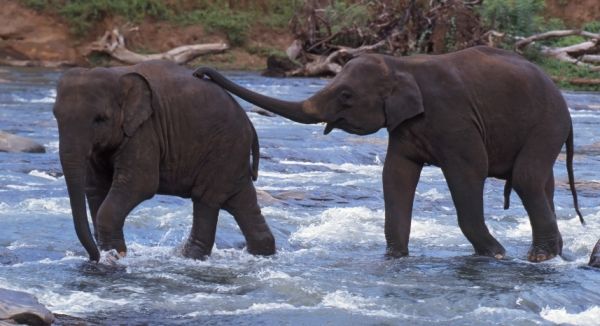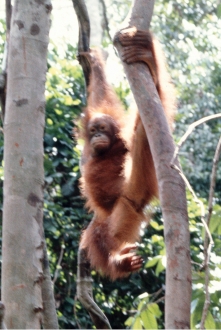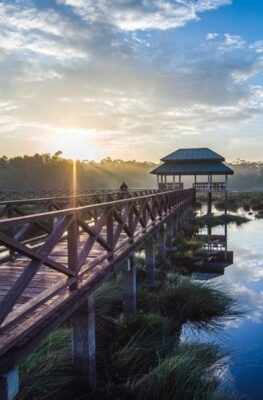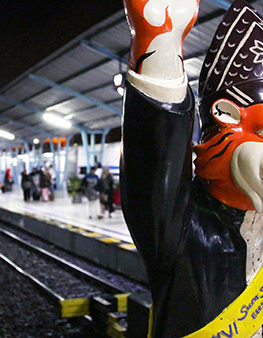Published on May 6, 2010

Any large animal could have trampled the plants beside the wooden walkway, but the footprints were unmistakable. Pygmy elephants wandered through our camp overnight, and we missed them.
This was to be our last morning at Bilit Adventure Camp (tel. +60 89-533031; www.sepilokjungleresort.com; two-night package starts at US$115), one of several lodges overlooking the Kinabatangan River and its tributaries. The area is considered one of the best places to see Borneo’s abundant wildlife, with the distinction of being one of only two locations in the world that supports 10 species of primates.
The two-hour drive to the camp from Sandakan, itself a short flight or eight-hour bus ride from Kota Kinabalu, had taken us through mile after mile of uniform stretches of palm oil plantations. Things began to look more promising when we arrived at the village of Bilit, clambered down a rickety jetty to board a small boat, and got our first sight of the strip of jungle designated as a wildlife sanctuary.
Tourism has flourished since the first lodge opened in 1991, and there are now at least a dozen places aimed at a range of budgets. Uncle Tan’s (tel. +60 89-53578; http://www.uncletan.com; two-night package US$87), for example, attracts backpackers with its affordable basic accommodation. We chose it for its home comforts, a series of well maintained wooden cabins offering either fans or air-conditioning.
After a short briefing we set off on our first river cruise. Logging upriver has left the Kinabatangan a muddy brown, but other than watching out for monitor lizards and crocodiles, we were more interested in the jungle than the water. Within minutes we saw boats crowding around a spot on the opposite side of the river.
“Pygmy elephants,” our guide Mus assured us, although we could see nothing. Endemic to Borneo, pygmy elephants have large ears and longtails; they are smaller than other Asian elephants, although the males can still reach 2.5 meters in height. With the World Wildlife Fund estimating that there are only around 1,000 in the wild, they are considered endangered due to human interference with their territory.
We waited unsuccessfully for a few minutes before we decided to head over. But with the other boats out of the way—in peak season clusters of up to 25 have been reported—we watched as the elephants slowly ate the vegetation that had been obscuring our view.
Next day, a worried Mus explained that the starting point of our scheduled jungle trek, heading to an oxbow lake for lunch, was exactly where we had seen the elephants. He hacked his way through the humid jungle, overgrown even on this well-used path, and occasionally stopped to listen. “If they are close then we have to leave,” he told us. “They can become aggressive if they think we are threatening their young.”
In the end, the elephants did not appear, and we scared the smaller wildlife away as we slipped our way along the muddy trail. There were plenty of insects around though—don’t forget the repellent! The optional nightwalk had a similar outcome, with too many people waving torches and talking loudly.
We did see a few interesting things, including a whip scorpion, a large millipede, and a couple of sleeping birds. I also brought a new friend back with me: a leech, which thankfully had not quite managed to get through my rented leech socks.
The three boat cruises were the real point of the trip, and we pretty much made our way through a check list of the key attractions. Mus seemed able to spot animals from unfeasibly long distances away, and provided interesting snippets of information. Long-tailed macaques, for example, apparently like to hang from trees and catch crabs withtheir tails.
Then there were the proboscis monkeys, truly bizarre creatures with big noses and potbellies. They stayed much higher up in the trees than the macaques, not so much leaping from branch to branch as falling in a barely controlled manner. Bird watchers were also well catered for, particularly on the misty early morning cruise, with more than 200 species recorded in the area.
Binoculars would not have been a bad idea, but the zoom lens on my camera helped me to get a decent view. On the last cruise we got to tick off one of the most important boxes on our imaginary checklist. Although around 3,500 orangutans live in the area, it is not common to see them; the one we spotted quickly turned its back on us, but it was still a thrill to see it inthe wild.
So when we spotted those elephant footprints outside our cabin on the last morning, we had no right to be disappointed. But, of course, we were. Then, settling down to breakfast, we heard banging coming from around the camp’s water storage tanks. Three of the elephants had returned, and although the camp staff looked concerned, they did not try to drive them away. So we did what self-respecting tourists would do and grabbed our cameras.
Insight
Borneo: Nature’s Hothouse
The third largest island in the world (with a land area of 744,108 sqm, it’s roughly twice the size of Germany), Borneo is divided between Indonesia, Malaysia, and Brunei. It is described by the World Wildlife Fund as “the only remaining place in Southeast Asia that still holds huge tracts of pristine forest.” The forests are the traditional home of more than 30 tribal groups collectively known as Dayaks. Many Dayaks live in individual dwellings, often resettled under government pressure, and where longhouses still exist they are usually built using concrete rather than natural materials.
Today, tribal groups account for around a quarter of Borneo’s population. Other groups include the Chinese whose ancestors arrived in the 19th century, Malays from the Malaysian Peninsular, and large numbers of Indonesians who were encouraged to settle in Borneo in the 70’s and 80’s—the last of them causing significant resentment among indigenous groups.
Kings of the Swingers

Orangutans are the largest living forest-dwelling animals, with habitats in Borneo and Sumatra (Indonesia), and feed mostly on fruits. They are highly solitary creatures, with males and females usually coming together only to mate, which is one of the reasons why they are hard to find in the wild. Some males have distinctive flanged cheek pads and are fiercely territorial, while females and unflanged males do not establish territories. Studies suggest that, after humans, orangutans are the most intelligent animals on earth, able to use tools and solve quite complex problems. Bornean orangutans are an endangered species, with a rapid decline in population over the past few decades due to human activity— including logging, mining, hunting, and forest fires. The conversion of forest to palm oil plantations has been particularly harmful. Efforts have been made to highlight the plight of orangutans, including celebrity intervention such as Julia Roberts’ famous In The Wild documentary in 1999, but the threat of extinction remains very real.
The Sepilok Orangutan Sanctuary (tel. +60 89 531180), a shortdrive from Sandakan, cares for orphaned animals and has feeding times at 10a.m. and 2:30 p.m.
Keeping Kinabatangan
The World Wildlife Fund (http://www.wwf.org.my) has called for more regulation and self-evaluation within the Kinabatangan tourist industry ,expressing concern about:
• Guides taking tourists too close to elephants
• The use of noisy and polluting outboard motors
• A reluctance to reprimand tourists who behave inappropriately
• Overcrowding
John Oates is a freelance writer/photographer and has travelled through much ofAsia. He recently spent a year based inthe Philippines while visiting several other ASEAN countries.Contact John at http://www.johnoates.co.uk.
This article was provided by Philippine Airlines’ Mabuhay Magazine.Mabuhay Magazine is published by Eastgate Publishing Corporation (email:info@eastgatepublishing.com;website: http://www.eastgatepublishing.com).






